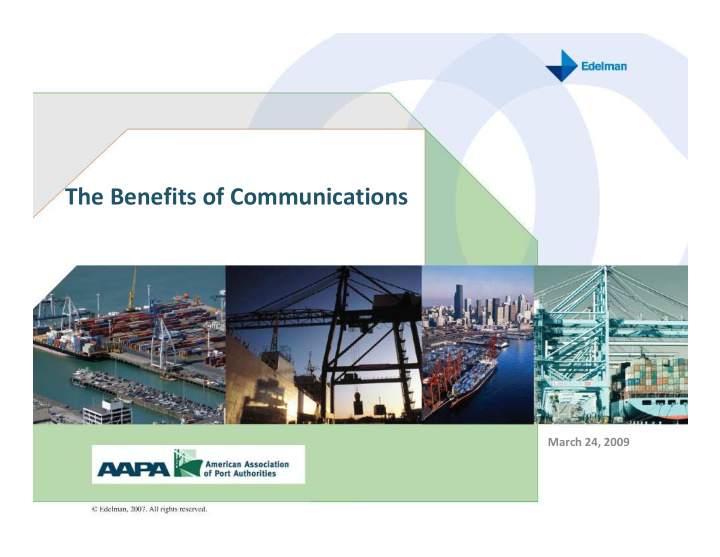



The Benefits of Communications March 24, 2009
Why do trade groups invest in communications?
To advance or protect the business interests of their members.
How do trade groups accomplish this basic objective? � Rely on market research to gauge awareness and perceptions among key stakeholders � Develop messages that promote the positive societal benefits derived from an industry � Forge productive relationships with consequential third parties who can speak positively—and independently—on behalf of an industry � Deliver messages to key stakeholders through media relations, advertising, social media and one-on-one interactions � Not least, the most successful trade groups act in advance of opportunities and threats
What current trends are relevant to communications? � Both the administration and Congress have indicated a willingness to reconsider, if not overhaul, longstanding policies in a variety of fields � The federal government has been dispensing hundreds of billions of dollars to state and local governments—a trend many expect to continue � Trust of business and large institutions, both public and private, is at an all-time low � Now more than ever, the perception among government officials of an industry is relative to one’s peers
Edelman’s Work-to-Date (April 2008 – March 2009) � Message Workshop and Message Development � Communication Audit � Materials Development � Influencer Analysis and Outreach � Media Training � Media Outreach – Deskside Briefings � Messaging and Communications Guide � Seaports Magazine article � Salon � Thought Leadership Recommendations � Strategic Counsel
Results � Established relationships and secured interviews with elite, national media including: � Chris Conkey, transportation reporter, The Wall Street Journal � Alex Roth, transportation and shipping reporter, The Wall Street Journal � Josh Mitchell, transportation reporter, Dow Jones Newswire � Angela Greiling Keane, freight transportation reporter, Bloomberg � Colby Itkowitz, transportation reporter, Congressional Quarterly � Joseph J. Schatz, trade reporter, Congressional Quarterly � Lisa Caruso, staff reporter, National Journal
Results � Planned and executed a salon event for influencers and media � Invitees included the national and trade media, academics and think-tanks � Participants included representatives from organizations such as the U.S. Department of Transportation, the U.S. Chamber of Commerce, Brookings Institution, The Heritage Foundation, the Federal Highway Administration, the U.S. Department of Transportation Maritime Administration and Neuberger Investment Management � The salon resulted in the resulting following meetings to-date (Edelman will continue select outreach to key salon invitees): � Daniella Markheim, Jay Van Andel senior analyst in trade policy, The Heritage Foundation � Richard Hillestad, senior principal researcher, RAND � Janet Kavinoky, director, U.S. Chamber of Commerce)
Results � Enabled AAPA to become part of the discussion on the stimulus bill and infrastructure spending including: � Inclusion of seaports in President Obama’s first Saturday radio address � Participation in a conference call with U.S. Transportation Secretary Ray LaHood in which the needs of seaports were discussed � Inclusion of seaports in U.S. Transportation Secretary Ray LaHood’s statement following the signing of the stimulus bill
What more should AAPA be doing? � Enhancing the overall program to reach more of your stakeholders more frequently � Promote the essential benefits derived from U.S. ports, including your contributions to the national economy � Leveraging the benefits resulting from the shift to online media, including blogging and stakeholder engagement � Target select markets based on the leadership of key Congressional committees � Increase the number and activism of your third party advocates
Recommend
More recommend